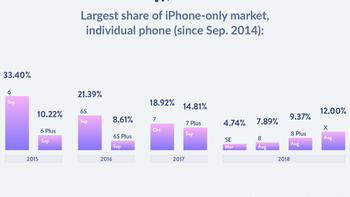The price of the Apple iPhone X has caused a shift in the iPhone market

With the launch of the Apple iPhone 6 and iPhone 6 Plus in 2014, Apple started offering a regular sized model and a "Plus" variant every year. According to a chart created by business analytical firm Mixpanel, it has been traditional for the lower priced, regular sized iPhone to grab a larger share of iPhone sales than the "Plus" variant during the course of the year following the release of the latest models.
For example, in 2015 the Apple iPhone 6 had a 33.40% share of iPhone sales compared to the 10.22% that belonged to the iPhone 6 Plus. The next year's iPhone 6s grabbed 21.39% of the iPhone market overwhelming the 8.61% belonging to the iPhone 6s Plus. The pattern continued in 2016 with the iPhone 7 and iPhone 7 Plus, although the difference in market share between the two was pretty slim.
The pattern looks like it will be broken with the iPhone 8 and iPhone 8 Plus. Through August, the former has a 7.89% slice of the iPhone pie, while the latter owns 9.37% of the iOS handset market. It is clear to see that this turn of events can be "blamed" on the Apple iPhone X. The tenth anniversary iPhone has a 12% iPhone market share, but it also has a very high price ($999 for the 64GB model and $1,149 for the 256GB variant). As a result, the iPhone X makes the iPhone 8 Plus ($799 for 64GB, $949 for 256GB) look like a bargain. This drives sales to the iPhone 8 Plus, allowing it to be the first "Plus" iPhone model to score a higher share of iPhone sales than the less expensive, regular sized version.
This year's iPhone line up will be configured much differently as we expect to see a 6.5-inch iPhone Xs Max, a 5.8-inch iPhone Xs and a more affordable iPhone Xc with a 6.1-inch LCD display. While most analysts expect the iPhone Xc to outsell the other two units because of price, the sheer size of the iPhone Xs Max has many phone buyers talking about purchasing that model.










Things that are NOT allowed: